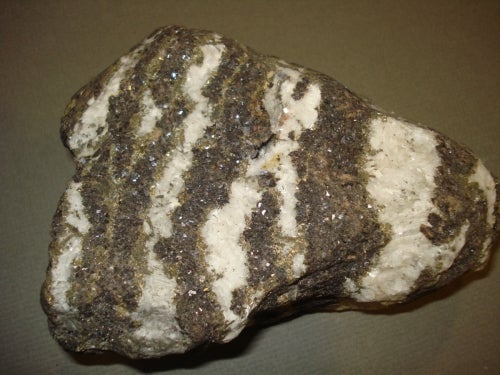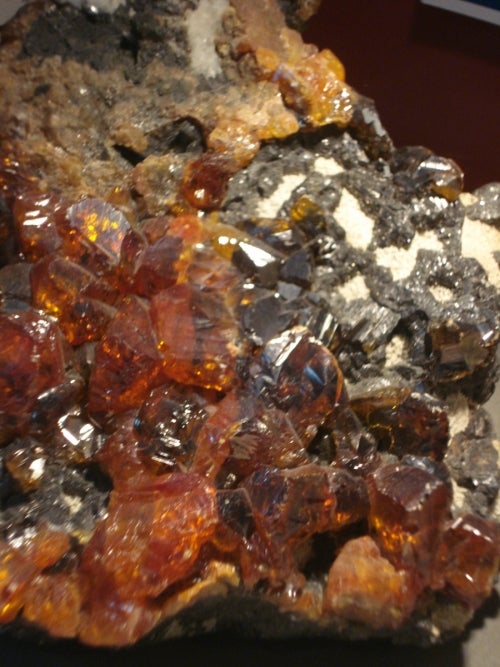Back to Rocks and Minerals Articles
Peter Russell and Tharsika Tharmanathan
Zinc (Zn) is a bluish-white shiny metal that is fragile at room temperature, but becomes malleable at 100 degrees Celsius. Zinc is one of the most common elements in the Earth’s crust. It is found in soil, air, and water and is present in food. Zinc was used in Rome and China more than 2000 years ago as a component of brass (see What on Earth winter 2003 issue, zinc-copper alloy). Commercial production of zinc did not start in Europe until the middle of the 18th century and in the United States until 1860. Zinc metal has never been found naturally. The great majority of zinc deposits contain the lead mineral, galena, and both the lead and zinc minerals are mined together. Other metals that are found with zinc are silver and copper. Zinc-Copper ores could be smelted into brass. Zinc also exists as a variety of salts and combines with other elements, such as chlorine, oxygen, and sulphur, to form zinc compounds.
Zinc is mined in over 50 countries with Canada being the leading producer, followed by Russia, Australia, Peru, United States and China. Deposits of zinc-bearing ores are found in most provinces of Canada, as well as in the Yukon and North West Territories. Zinc sulphide (ZnS), sphalerite, is the most common mineral containing zinc.
Pine Point Mine
In 1898, galena was shown by natives to prospectors travelling to the Klondike gold fields. By 1930, Northern Lead Zinc Limited started work on lead - zinc sinkholes. The Great Depression halted this work. Company reports indicated over 500,000 tons of reserves. In 1951 a company called Pine Point Mines was established. A much larger company, the Consolidated Mining and Smelting company, (now called Cominco) then began construction of a large mill and 50 homes in the early 1960s. The Pine Point townsite soon had all the amenities of a modern community. In 1981, the population was 1861. About 10,000 tons-per-day of ore were produced at that time. Over $2 billion worth of zinc and lead (at today's prices) was recovered by Cominco during 25 years. Low base metal prices and high recovery costs forced Cominco to shut down operations in 1988, and the mine and townsite have been rehabilitated.
Red Dog Mine, Alaska
Pine Point was closed at the same time Cominco was developing the Red Dog Mine in Alaska. The Red Dog Mine combined lead-zinc averages 24% with a credit of around 90 grams of silver per ton. Cominco decided to focus its resources on developing the Red Dog Mine which has the largest annual production and is the most profitable zinc mine in the world.
Kidd Creek Mine (Falconbridge)
Kidd Creek Mine (Falconbridge) at Timmins, Ontario, produces ore containing zinc, copper, lead, silver and cadmium.

Zinc Ore. Nanisivik, Baffin Island, Nunavut. University of Waterloo Earth Sciences Museum Collection.
Uses of zinc
Zinc is essential to a healthy life for humans and animal. It is necessary for the function of different enzymes. It is necessary for skin and bone growth. Above all, the body uses zinc to process food and nutrients. When zinc is alloyed with other metals, it becomes a good electrical conductor. Zinc-bromide and zinc-nickel power cells are amongst the newest types of batteries.
Minerals, which occur naturally in the Earth's crust, perform vital roles in our everyday lives. But few of us ever make the connection between these objects, appliances and materials we use and which help us make our life easier. The following is a list of few materials and appliances where Zinc is used.
- Antiseptic ointments
- Acne and poison ivy preparations
- Athlete's foot preparations
- Battery Electrodes
- Brass (20-45% is zinc)
- Calamine lotion for healing skin disorders
- Ceramic glazes
- Chemical catalysts
- Cosmetics
- Dandruff shampoos
- Deoderant
- Diaper rash ointments
- Dry batteries
- Dye
- Electronic devices
- Fluorescent lights
- Fungus retardants
- Glues
- Luminous dials on watches
- Ointments
- Paints
- Canadian and U.S. newer pennies
- Pharmaceuticals
- Plastics prevents cracking
- Printing inks
- Retard corrosion of ship hulls, pipelines, automobiles
- Roof cladding
- Rubber products
- Sheet zinc
- Sunscreen
- Textiles
- TV screens
- Wood preservatives
- X-ray
To protect from rusting, Zinc is applied in thin layers to iron and steel products. This process is called galvanizing. More than half of the zinc consumed is used for galvanizing. Galvanizing is done in a number of ways. Usually, the metal is dipped in molten zinc. It can also be done by electroplating or by painting on a layer of zinc compound. More than half of the zinc consumed is used for galvanizing. Zinc makes the average vehicle last longer. About 7.7 kilograms of zinc is used to protect the average automobile from rust. Another 9 kilograms are used to make zinc die cast parts like door handles and locks, and each tire contains about quarter of a kilogram of zinc, which is needed to cure the rubber.
Recently zinc metal is being applied to buildings due to its long, maintenance-free life and its ability to adapt to various design styles. Zinc's subtle colour is being praised by architects who say its colour gets richer as the material adapts to specific atmospheric conditions and blends beautifully with other building materials such as concrete and wood. It is also easy to work with to form complex shapes.
In the United States, zinc is mined in several states. Alaska produces the most, followed by Tennessee, and Missouri.
Mississippi valley lead-zinc deposits
Mississippi Valley Lead-Zinc deposits are a family of ore deposits formed by sea water flowing through sedimentary rocks including limestone, dolostone, salt and shale. The brines (seawater) flows through these recently deposited sediments reacting with the limestone and changing it with addition of magnesium from the water. Calcium in calcite is replaced by magnesium forming the mineral dolomite. This reaction usually destroys fossils in the limestone and forms holes in the rocks, which are then good places where lead-zinc minerals may form. Brines flowing through other sediments such as shale may pick up lead and zinc from them. The water then flows through dolostones which are now at a depth where oil migrates through the rock. The oil migrates upwards bringing sulphur with it. The sulphur from the oil interacts with the brines containing lead and zinc sulphide in the holes in the dolostone depositing galena and sphalerite. Bacterial action assists this process. Other minerals form later such as calcite.
Mississippi valley deposits are found in mid-west United States. They are also found at Navisivik on Baffin Island. Alaska produces the most, followed by Tennessee, and Missouri.
Lead-zinc deposits are found in dolostones of southern Ontario. The they reason we haven't gotten mined is that holes formed in the dolostone before mineralization were not large enough to host economic deposits. These types of deposits are common worldwide.
Volcanigenic massive sulphide deposits
Volcanogenic massive sulphide deposits are a major source of copper, zinc, lead, silver and gold. These deposits have been found actively forming at a temperature of 350 degrees Celsius. Hydrothermal vents on spreading ocean bottom ridges, such as those found in the eastern Pacific Ocean are actively precipitating metal sulphides. These deposits are formed by the discharge of solution into the seafloor.

Sphalerite, or Zinc Sulphate. University of Waterloo Earth Sciences Museum Collection.
Oxidized zone minerals
Zinc sulphide is oxidized and enriched by interaction with the atmosphere, naturally acidic rainwater and nearby rocks and minerals (see "Copper the Red Metal", Wat on Earth, winter issue 2003). Zinc sulphide is changed to zinc sulphate. This solution trickles down through the deposits. Oxidized minerals form, such as Hemimorphite and lower down in the deposits the sulphate reacts with limestone and other rocks containing calcium forming zinc carbonate (Smithsonite).
Copper into gold
A copper penny is placed in an evaporating dish and heated with a mixture of sodium hydroxide solution and zinc. It turns silver. The penny is then heated in a burner flame and it suddenly turns gold!
Procedure
- Place about 5 grams of zinc dust in an evaporating dish.
- And enough NaOH solution to cover the zinc and fill the dish about one-third.
- Place the dish over a burner, or hot plate until the solution is near boiling.
- Prepare a copper penny by cleaning it thoroughly with a light abrasive (Brillo pads work well).
- Using crucible tongs, or tweezers, place the cleaned penny in the mixture in the dish.
- Hold the penny in the dish for 3-4 minutes. You will be able to tell when the coating is complete.
- Remove the penny, wash it, and blot dry with paper towels. (Do not rub.)
- Using tweezers, hold the coated penny in the flame of a burner. The production of the gold colour is immediate.
- After 3-5 seconds, remove the coin, wash it, and dry it.
Reactions
- The first reaction is the plating of the copper with zinc: Zinc reacts with sodium hydroxide to form sodium zincate, Na2ZnO2. This product is then reduced by the copper penny to metallic zinc. This reaction gives the silver colour to the penny.
- The second reaction is the formation of the brass alloy. This alloy gives the penny the gold colour. Heat causes a fusion of the zinc and copper.
Solution
The sodium hydroxide solution is 6 M: Dissolve 240 g of NaOH per litre.
This experiment was taken from Chemical Demonstration by Lee R. Summerlin and James L. Ealy, Jr., 1985, American Chemical Society, Washington, DC.
Web resources
*The links were taken down as this article was published in November 2003 and none of the websites used to write this article were still in use.